Reinhard Diestel
Graph Theory
Electronic Edition 2005
c Springer-Verlag Heidelberg, New York 1997, 2000, 2005
This is an electronic version of the third (2005) edition of the above
Springer book, from their series Graduate Texts in Mathematics, vol. 173.
The cross-references in the text and in the margins are active links: click
on them to be taken to the appropriate page.
The printed edition of this book can be ordered via
http://www.math.uni-hamburg.de/home/diestel/books/graph.theory/
where also errata, reviews etc. are posted.
Substantial discounts and free copies for lecturers are available for course
adoptions; see here.
�
Preface
Almost two decades have passed since the appearance of those graph the-
ory texts that still set the agenda for most introductory courses taught
today. The canon created by those books has helped to identify some
main fields of study and research, and will doubtless continue to influence
the development of the discipline for some time to come.
Yet much has happened in those 20 years, in graph theory no less
than elsewhere: deep new theorems have been found, seemingly disparate
methods and results have become interrelated, entire new branches have
arisen. To name just a few such developments, one may think of how
the new notion of list colouring has bridged the gulf between invari-
ants such as average degree and chromatic number, how probabilistic
methods and the regularity lemma have pervaded extremal graph theory
and Ramsey theory, or how the entirely new field of graph minors and
tree-decompositions has brought standard methods of surface topology
to bear on long-standing algorithmic graph problems.
Clearly, then, the time has come for a reappraisal: what are, today,
the essential areas, methods and results that should form the centre of
an introductory graph theory course aiming to equip its audience for the
most likely developments ahead?
I have tried in this book to offer material for such a course.
In
view of the increasing complexity and maturity of the subject, I have
broken with the tradition of attempting to cover both theory and appli-
cations: this book offers an introduction to the theory of graphs as part
of (pure) mathematics; it contains neither explicit algorithms nor ‘real
world’ applications. My hope is that the potential for depth gained by
this restriction in scope will serve students of computer science as much
as their peers in mathematics: assuming that they prefer algorithms but
will benefit from an encounter with pure mathematics of some kind, it
seems an ideal opportunity to look for this close to where their heart lies!
In the selection and presentation of material, I have tried to ac-
commodate two conflicting goals. On the one hand, I believe that an
�
viii
Preface
introductory text should be lean and concentrate on the essential, so as
to offer guidance to those new to the field. As a graduate text, moreover,
it should get to the heart of the matter quickly: after all, the idea is to
convey at least an impression of the depth and methods of the subject.
On the other hand, it has been my particular concern to write with
sufficient detail to make the text enjoyable and easy to read: guiding
questions and ideas will be discussed explicitly, and all proofs presented
will be rigorous and complete.
A typical chapter, therefore, begins with a brief discussion of what
are the guiding questions in the area it covers, continues with a succinct
account of its classic results (often with simplified proofs), and then
presents one or two deeper theorems that bring out the full flavour of
that area. The proofs of these latter results are typically preceded by (or
interspersed with) an informal account of their main ideas, but are then
presented formally at the same level of detail as their simpler counter-
parts. I soon noticed that, as a consequence, some of those proofs came
out rather longer in print than seemed fair to their often beautifully
simple conception. I would hope, however, that even for the professional
reader the relatively detailed account of those proofs will at least help
to minimize reading time. . .
If desired, this text can be used for a lecture course with little or
no further preparation. The simplest way to do this would be to follow
the order of presentation, chapter by chapter: apart from two clearly
marked exceptions, any results used in the proof of others precede them
in the text.
Alternatively, a lecturer may wish to divide the material into an easy
basic course for one semester, and a more challenging follow-up course
for another. To help with the preparation of courses deviating from the
order of presentation, I have listed in the margin next to each proof the
reference numbers of those results that are used in that proof. These
references are given in round brackets: for example, a reference (4.1.2)
in the margin next to the proof of Theorem 4.3.2 indicates that Lemma
4.1.2 will be used in this proof. Correspondingly, in the margin next to
Lemma 4.1.2 there is a reference [ 4.3.2 ] (in square brackets) informing
the reader that this lemma will be used in the proof of Theorem 4.3.2.
Note that this system applies between different sections only (of the same
or of different chapters): the sections themselves are written as units and
best read in their order of presentation.
The mathematical prerequisites for this book, as for most graph
theory texts, are minimal: a first grounding in linear algebra is assumed
for Chapter 1.9 and once in Chapter 5.5, some basic topological con-
cepts about the Euclidean plane and 3-space are used in Chapter 4, and
a previous first encounter with elementary probability will help with
Chapter 11. (Even here, all that is assumed formally is the knowledge
of basic definitions: the few probabilistic tools used are developed in the
�
Preface
ix
text.) There are two areas of graph theory which I find both fascinat-
ing and important, especially from the perspective of pure mathematics
adopted here, but which are not covered in this book: these are algebraic
graph theory and infinite graphs.
At the end of each chapter, there is a section with exercises and
another with bibliographical and historical notes. Many of the exercises
were chosen to complement the main narrative of the text: they illus-
trate new concepts, show how a new invariant relates to earlier ones,
or indicate ways in which a result stated in the text is best possible.
Particularly easy exercises are identified by the superscript −, the more
challenging ones carry a +. The notes are intended to guide the reader
on to further reading, in particular to any monographs or survey articles
on the theme of that chapter. They also offer some historical and other
remarks on the material presented in the text.
Ends of proofs are marked by the symbol . Where this symbol is
found directly below a formal assertion, it means that the proof should
be clear after what has been said—a claim waiting to be verified! There
are also some deeper theorems which are stated, without proof, as back-
ground information: these can be identified by the absence of both proof
and .
Almost every book contains errors, and this one will hardly be an
exception. I shall try to post on the Web any corrections that become
necessary. The relevant site may change in time, but will always be
accessible via the following two addresses:
http://www.springer-ny.com/supplements/diestel/
http://www.springer.de/catalog/html-files/deutsch/math/3540609180.html
Please let me know about any errors you find.
Little in a textbook is truly original: even the style of writing and
of presentation will invariably be influenced by examples. The book that
no doubt influenced me most is the classic GTM graph theory text by
Bollob´as: it was in the course recorded by this text that I learnt my first
graph theory as a student. Anyone who knows this book well will feel
its influence here, despite all differences in contents and presentation.
I should like to thank all who gave so generously of their time,
knowledge and advice in connection with this book.
I have benefited
particularly from the help of N. Alon, G. Brightwell, R. Gillett, R. Halin,
M. Hintz, A. Huck, I. Leader, T. Luczak, W. Mader, V. R¨odl, A.D. Scott,
P.D. Seymour, G. Simonyi, M. ˇSkoviera, R. Thomas, C. Thomassen and
P. Valtr. I am particularly grateful also to Tommy R. Jensen, who taught
me much about colouring and all I know about k-flows, and who invested
immense amounts of diligence and energy in his proofreading of the pre-
liminary German version of this book.
March 1997
RD
�
x
Preface
About the second edition
Naturally, I am delighted at having to write this addendum so soon after
this book came out in the summer of 1997. It is particularly gratifying
to hear that people are gradually adopting it not only for their personal
use but more and more also as a course text; this, after all, was my aim
when I wrote it, and my excuse for agonizing more over presentation
than I might otherwise have done.
There are two major changes. The last chapter on graph minors
now gives a complete proof of one of the major results of the Robertson-
Seymour theory, their theorem that excluding a graph as a minor bounds
the tree-width if and only if that graph is planar. This short proof did
not exist when I wrote the first edition, which is why I then included a
short proof of the next best thing, the analogous result for path-width.
That theorem has now been dropped from Chapter 12. Another addition
in this chapter is that the tree-width duality theorem, Theorem 12.3.9,
now comes with a (short) proof too.
The second major change is the addition of a complete set of hints
for the exercises. These are largely Tommy Jensen’s work, and I am
grateful for the time he donated to this project. The aim of these hints
is to help those who use the book to study graph theory on their own,
but not to spoil the fun. The exercises, including hints, continue to be
intended for classroom use.
Apart from these two changes, there are a few additions. The most
noticable of these are the formal introduction of depth-first search trees
in Section 1.5 (which has led to some simplifications in later proofs) and
an ingenious new proof of Menger’s theorem due to B¨ohme, G¨oring and
Harant (which has not otherwise been published).
Finally, there is a host of small simplifications and clarifications
of arguments that I noticed as I taught from the book, or which were
pointed out to me by others. To all these I offer my special thanks.
The Web site for the book has followed me to
http://www.math.uni-hamburg.de/home/diestel/books/graph.theory/
I expect this address to be stable for some time.
Once more, my thanks go to all who contributed to this second
edition by commenting on the first—and I look forward to further com-
ments!
December 1999
RD
�
Preface
xi
About the third edition
There is no denying that this book has grown. Is it still as ‘lean and
concentrating on the essential’ as I said it should be when I wrote the
preface to the first edition, now almost eight years ago?
I believe that it is, perhaps now more than ever. So why the increase
in volume? Part of the answer is that I have continued to pursue the
original dual aim of offering two different things between one pair of
covers:
• a reliable first introduction to graph theory that can be used either
• a graduate text that offers some depth in selected areas.
for personal study or as a course text;
For each of these aims, some material has been added. Some of this
covers new topics, which can be included or skipped as desired. An
example at the introductory level is the new section on packing and
covering with the Erd˝os-P´osa theorem, or the inclusion of the stable
marriage theorem in the matching chapter. An example at the graduate
level is the Robertson-Seymour structure theorem for graphs without a
given minor: a result that takes a few lines to state, but one which is in-
creasingly relied on in the literature, so that an easily accessible reference
seems desirable. Another addition, also in the chapter on graph minors,
is a new proof of the ‘Kuratowski theorem for higher surfaces’—a proof
which illustrates the interplay between graph minor theory and surface
topology better than was previously possible. The proof is complemented
by an appendix on surfaces, which supplies the required background and
also sheds some more light on the proof of the graph minor theorem.
Changes that affect previously existing material are rare, except for
countless local improvements intended to consolidate and polish rather
than change. I am aware that, as this book is increasingly adopted as
a course text, there is a certain desire for stability. Many of these local
improvements are the result of generous feedback I got from colleagues
using the book in this way, and I am very grateful for their help and
advice.
There are also some local additions. Most of these developed from
my own notes, pencilled in the margin as I prepared to teach from the
book. They typically complement an important but technical proof,
when I felt that its essential ideas might get overlooked in the formal
write-up. For example, the proof of the Erd˝os-Stone theorem now has
an informal post-mortem that looks at how exactly the regularity lemma
comes to be applied in it. Unlike the formal proof, the discussion starts
out from the main idea, and finally arrives at how the parameters to be
declared at the start of the formal proof must be specified. Similarly,
there is now a discussion pointing to some ideas in the proof of the perfect
graph theorem. However, in all these cases the formal proofs have been
left essentially untouched.
�
xii
Preface
The only substantial change to existing material is that the old
Theorem 8.1.1 (that cr2n edges force a T K r) seems to have lost its
nice (and long) proof. Previously, this proof had served as a welcome
opportunity to explain some methods in sparse extremal graph theory.
These methods have migrated to the connectivity chapter, where they
now live under the roof of the new proof by Thomas and Wollan that 8kn
edges make a 2k-connected graph k-linked. So they are still there, leaner
than ever before, and just presenting themselves under a new guise. As
a consequence of this change, the two earlier chapters on dense and
sparse extremal graph theory could be reunited, to form a new chapter
appropriately named as Extremal Graph Theory.
Finally, there is an entirely new chapter, on infinite graphs. When
graph theory first emerged as a mathematical discipline, finite and infi-
nite graphs were usually treated on a par. This has changed in recent
years, which I see as a regrettable loss: infinite graphs continue to pro-
vide a natural and frequently used bridge to other fields of mathematics,
and they hold some special fascination of their own. One aspect of this
is that proofs often have to be more constructive and algorithmic in
nature than their finite counterparts. The infinite version of Menger’s
theorem in Section 8.4 is a typical example: it offers algorithmic insights
into connectivity problems in networks that are invisible to the slick
inductive proofs of the finite theorem given in Chapter 3.3.
Once more, my thanks go to all the readers and colleagues whose
comments helped to improve the book. I am particularly grateful to Imre
Leader for his judicious comments on the whole of the infinite chapter; to
my graph theory seminar, in particular to Lilian Matthiesen and Philipp
Spr¨ussel, for giving the chapter a test run and solving all its exercises
(of which eighty survived their scrutiny); to Angelos Georgakopoulos for
much proofreading elsewhere; to Melanie Win Myint for recompiling the
index and extending it substantially; and to Tim Stelldinger for nursing
the whale on page 366 until it was strong enough to carry its baby
dinosaur.
May 2005
RD
�
Contents
Preface . . . . . . . . . . . . . . . . . . . . . . . . . . . . . . . . . . . . . . . . . . . . . . . . . . . . . . . . . . . . . . . . vii
1
1. The Basics . . . . . . . . . . . . . . . . . . . . . . . . . . . . . . . . . . . . . . . . . . . . . . . . . . . . . .
2
1.1 Graphs* . . . . . . . . . . . . . . . . . . . . . . . . . . . . . . . . . . . . . . . . . . . . . . . . . . . . . . . .
5
1.2 The degree of a vertex* . . . . . . . . . . . . . . . . . . . . . . . . . . . . . . . . . . . . . . . . .
6
1.3 Paths and cycles* . . . . . . . . . . . . . . . . . . . . . . . . . . . . . . . . . . . . . . . . . . . . . .
10
1.4 Connectivity* . . . . . . . . . . . . . . . . . . . . . . . . . . . . . . . . . . . . . . . . . . . . . . . . . .
1.5 Trees and forests* . . . . . . . . . . . . . . . . . . . . . . . . . . . . . . . . . . . . . . . . . . . . . .
13
1.6 Bipartite graphs* . . . . . . . . . . . . . . . . . . . . . . . . . . . . . . . . . . . . . . . . . . . . . . . 17
1.7 Contraction and minors* . . . . . . . . . . . . . . . . . . . . . . . . . . . . . . . . . . . . . . .
18
1.8 Euler tours* . . . . . . . . . . . . . . . . . . . . . . . . . . . . . . . . . . . . . . . . . . . . . . . . . . . . 22
23
1.9 Some linear algebra . . . . . . . . . . . . . . . . . . . . . . . . . . . . . . . . . . . . . . . . . . . .
28
1.10 Other notions of graphs . . . . . . . . . . . . . . . . . . . . . . . . . . . . . . . . . . . . . . . .
30
Exercises . . . . . . . . . . . . . . . . . . . . . . . . . . . . . . . . . . . . . . . . . . . . . . . . . . . . . . .
Notes . . . . . . . . . . . . . . . . . . . . . . . . . . . . . . . . . . . . . . . . . . . . . . . . . . . . . . . . . .
32
2. Matching, Covering and Packing . . . . . . . . . . . . . . . . . . . . . . . . . . . . .
2.1 Matching in bipartite graphs* . . . . . . . . . . . . . . . . . . . . . . . . . . . . . . . . . .
2.2 Matching in general graphs(∗) . . . . . . . . . . . . . . . . . . . . . . . . . . . . . . . . . . .
34
39
2.3 Packing and covering . . . . . . . . . . . . . . . . . . . . . . . . . . . . . . . . . . . . . . . . . . .
44
2.4 Tree-packing and arboricity . . . . . . . . . . . . . . . . . . . . . . . . . . . . . . . . . . . . . 46
2.5 Path covers . . . . . . . . . . . . . . . . . . . . . . . . . . . . . . . . . . . . . . . . . . . . . . . . . . . .
49
51
Exercises . . . . . . . . . . . . . . . . . . . . . . . . . . . . . . . . . . . . . . . . . . . . . . . . . . . . . . .
Notes . . . . . . . . . . . . . . . . . . . . . . . . . . . . . . . . . . . . . . . . . . . . . . . . . . . . . . . . . .
53
33
* Sections marked by an asterisk are recommended for a first course.
Of sections marked (∗), the beginning is recommended for a first course.
�
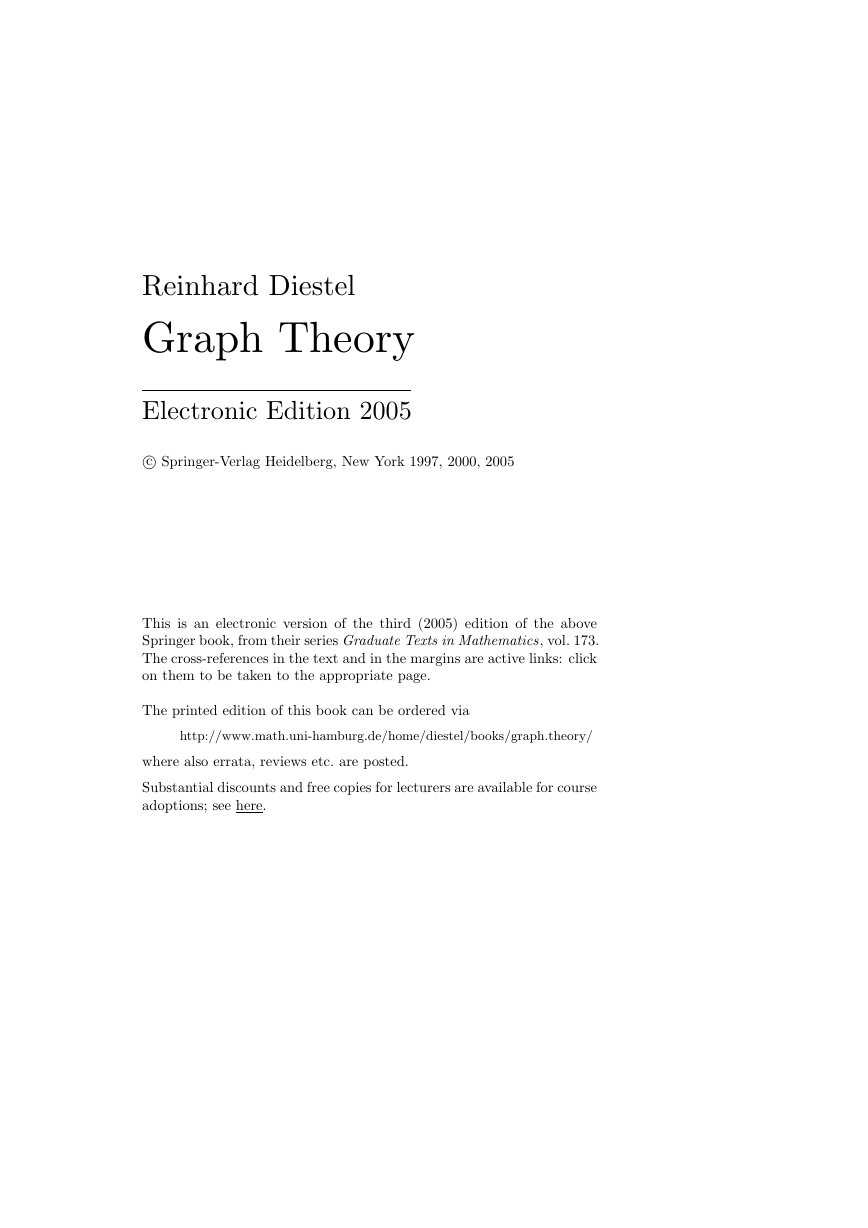
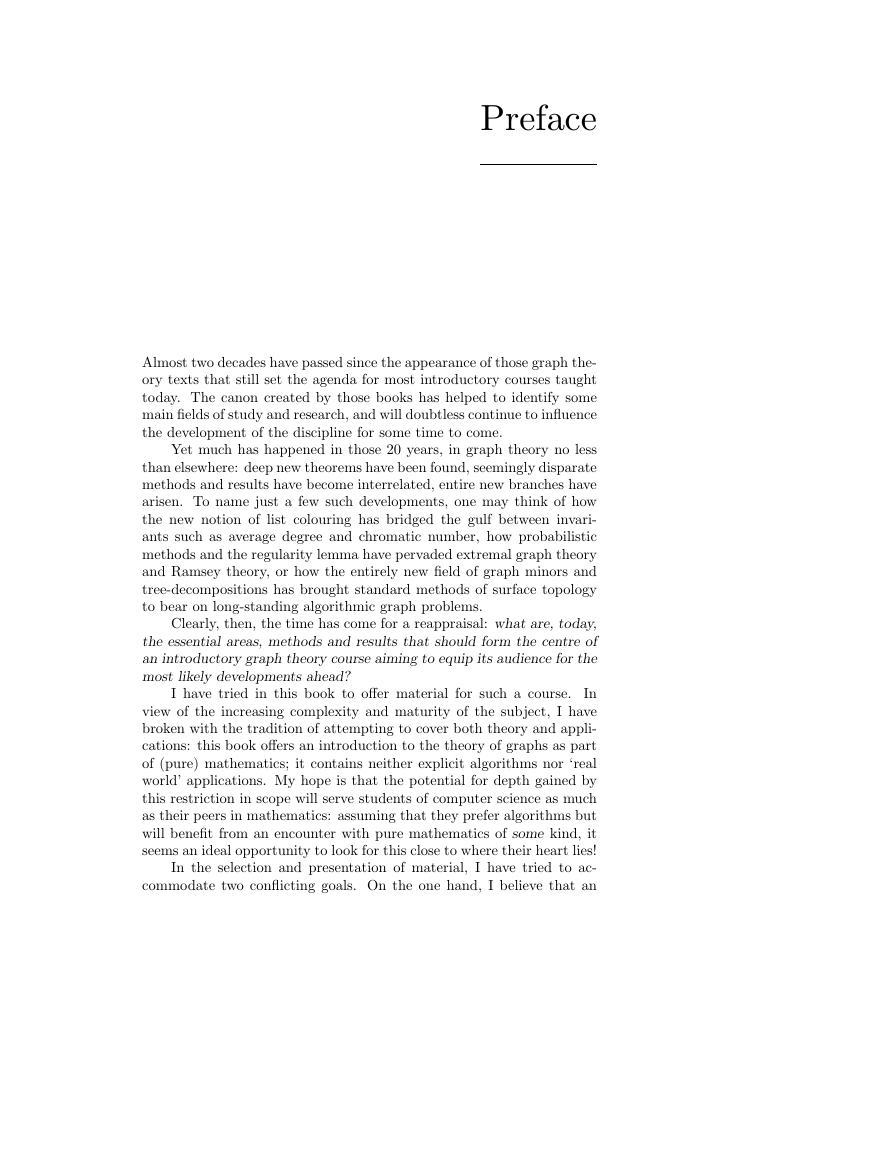
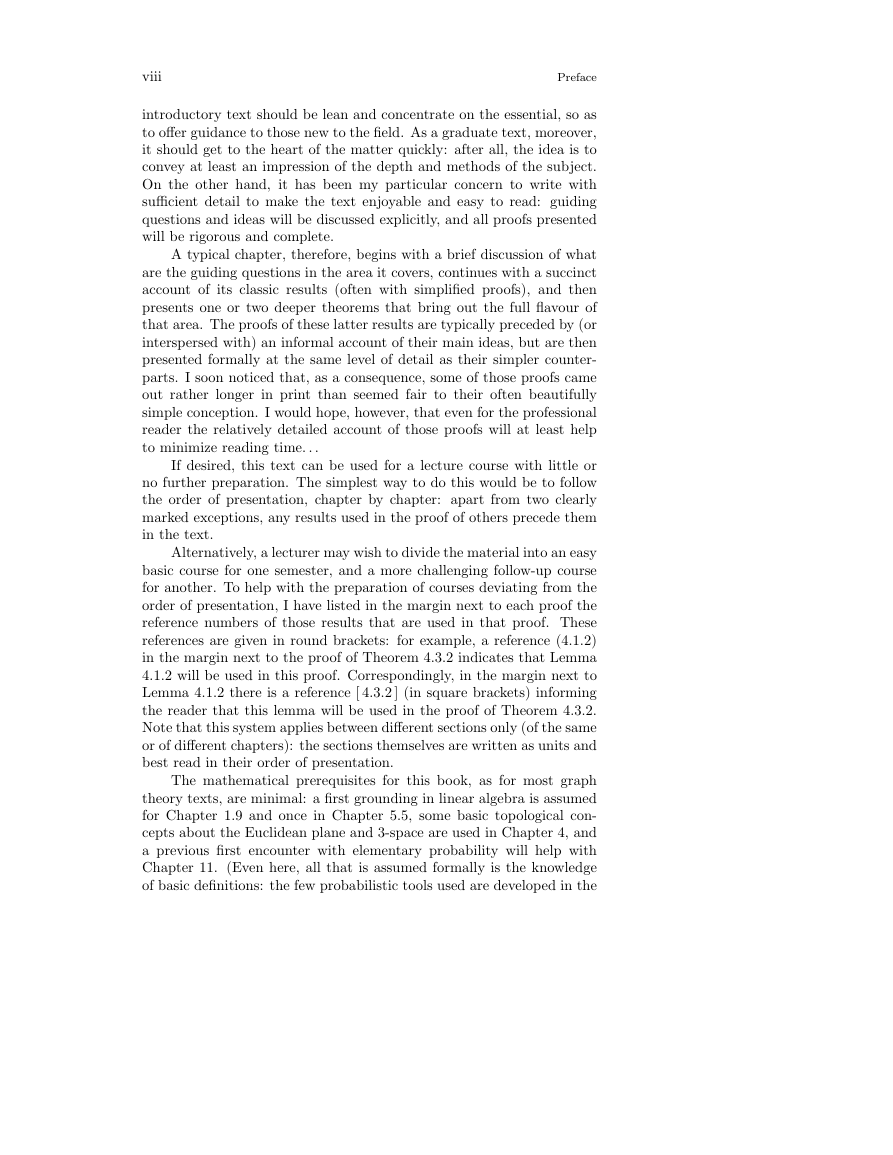
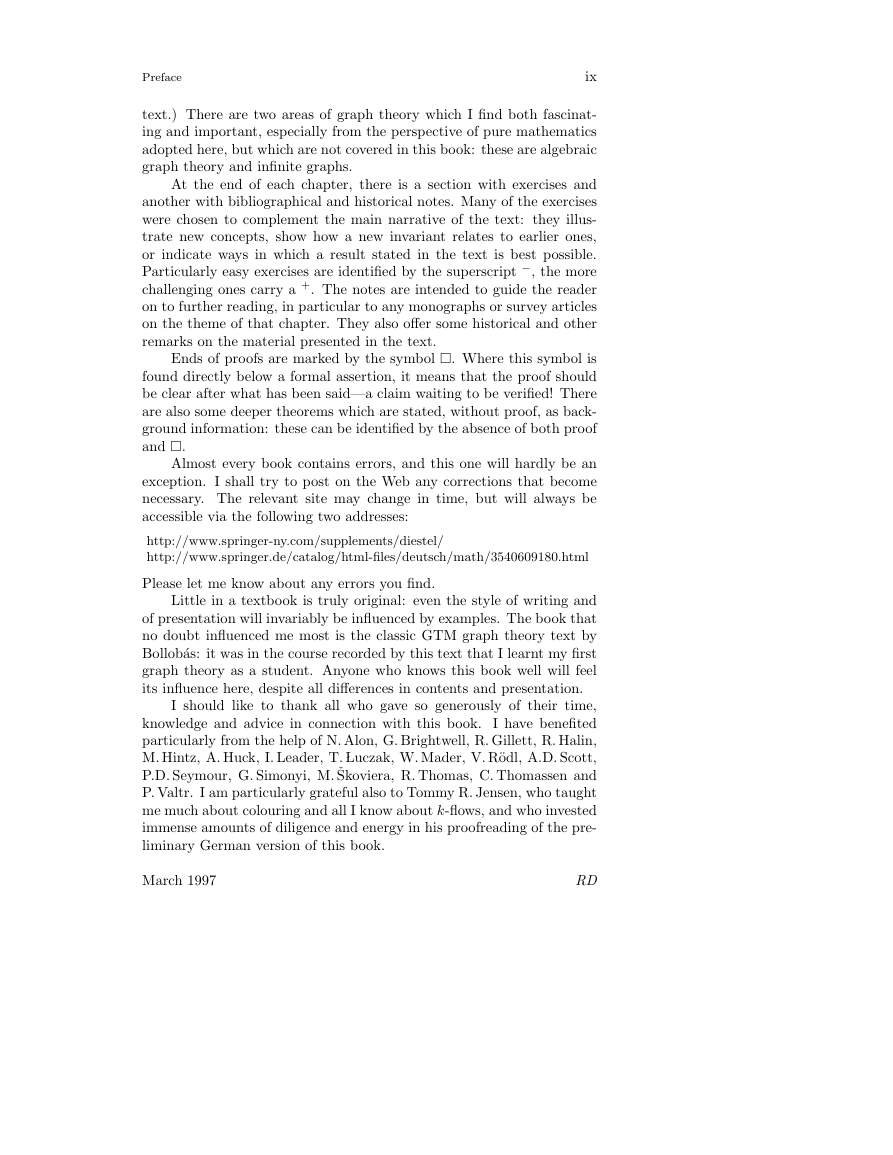
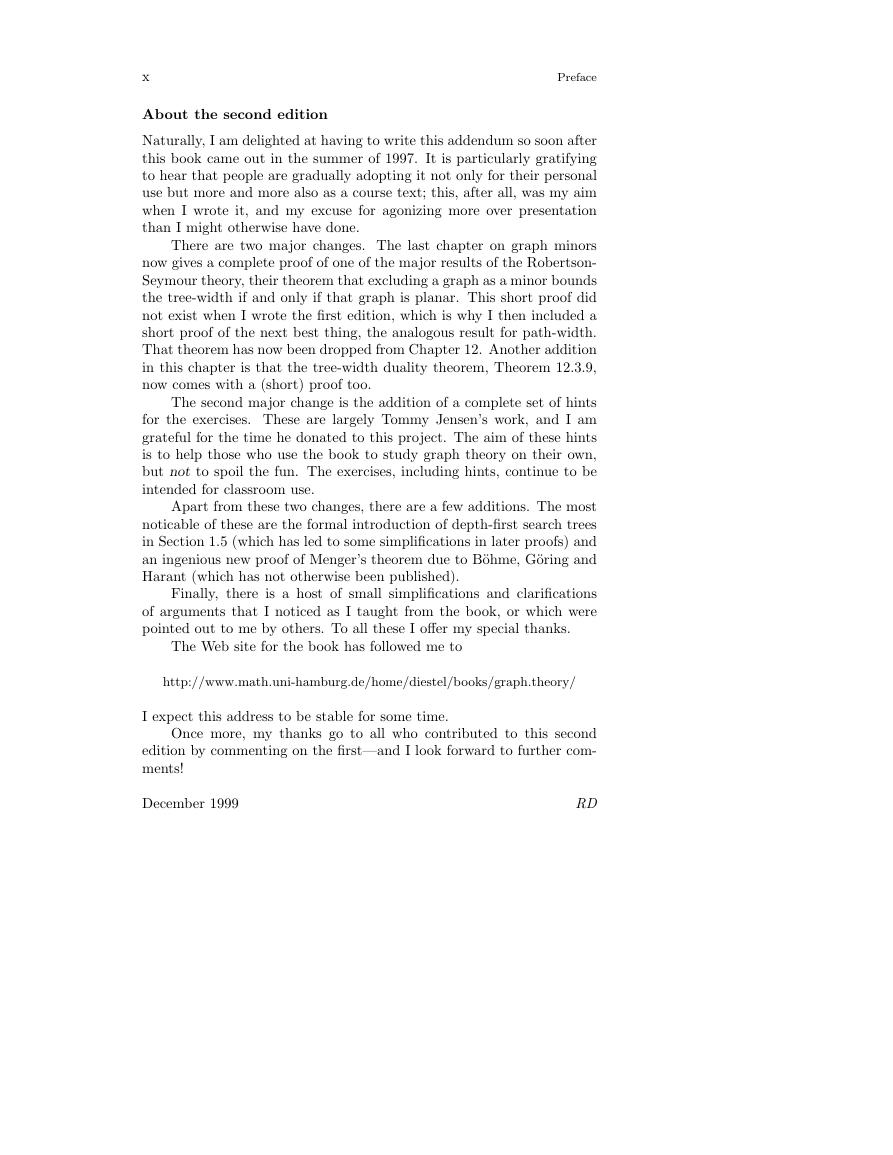
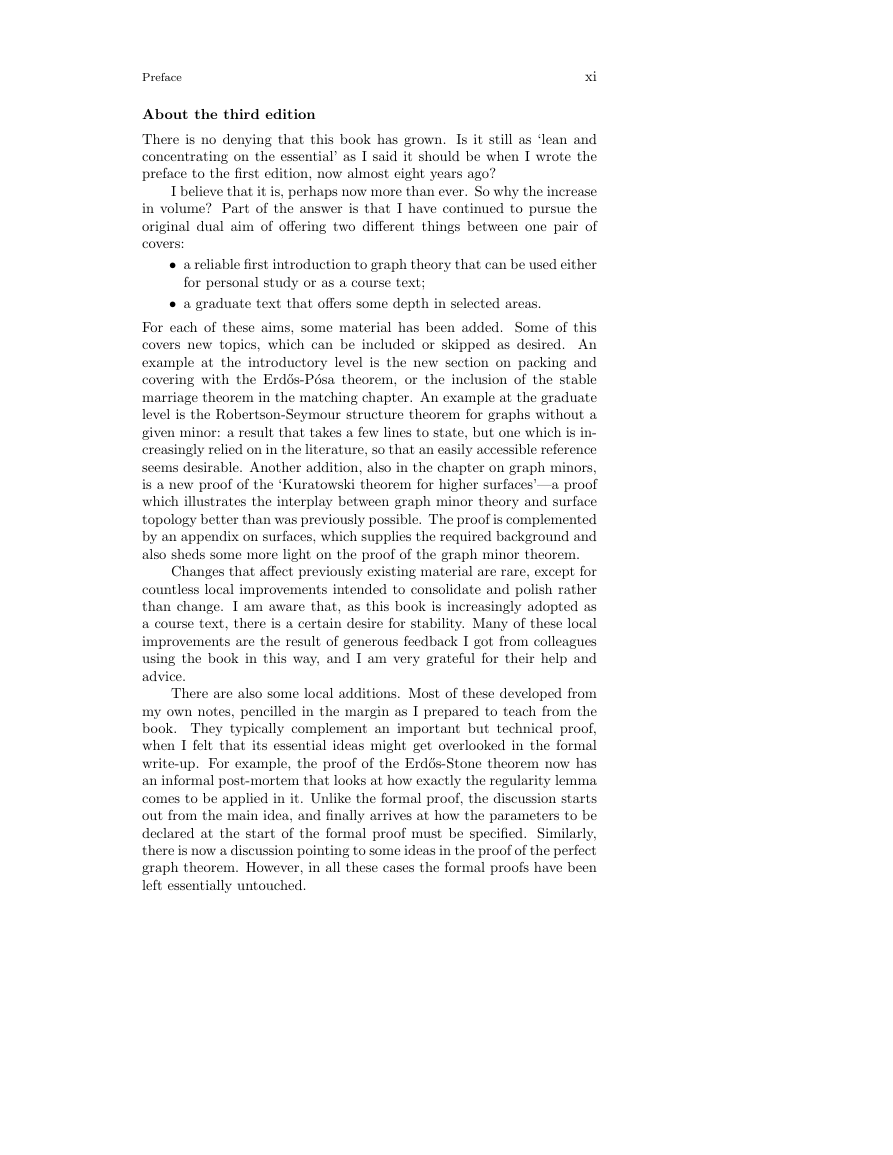
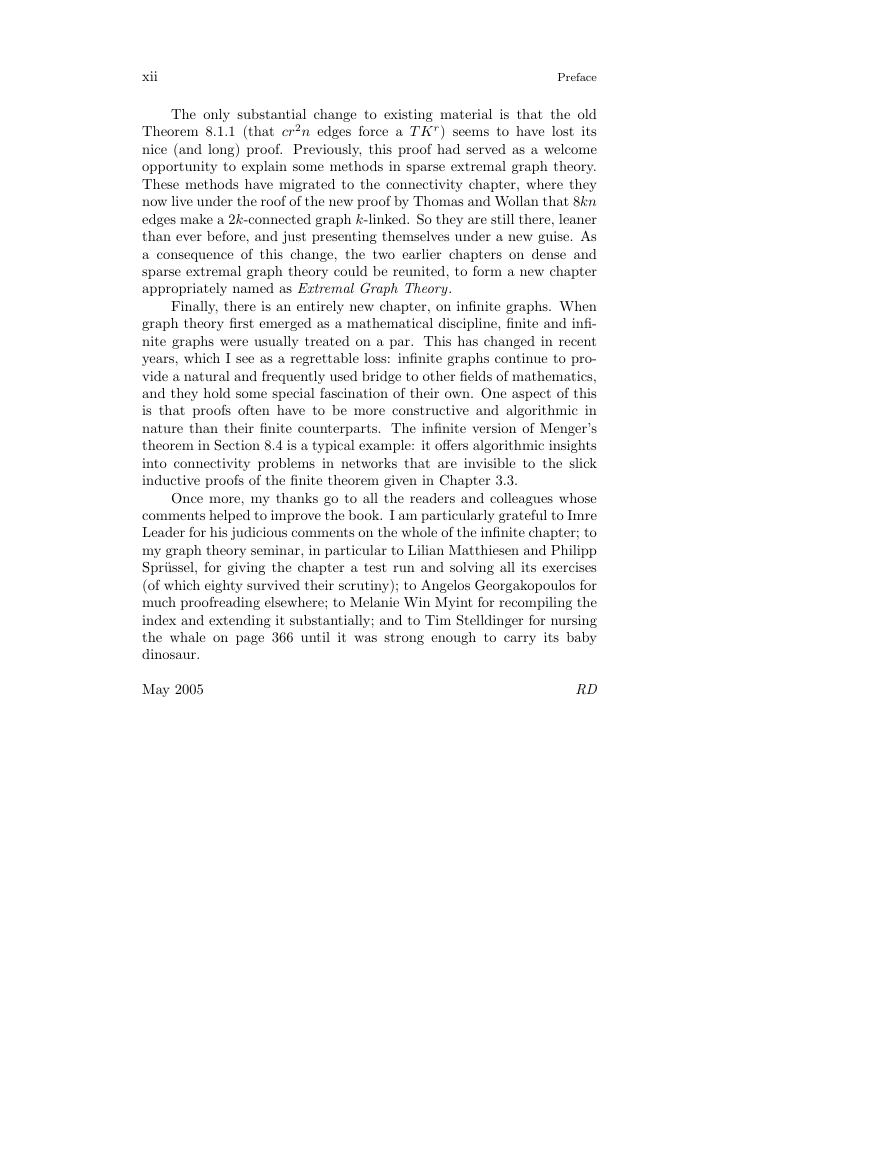
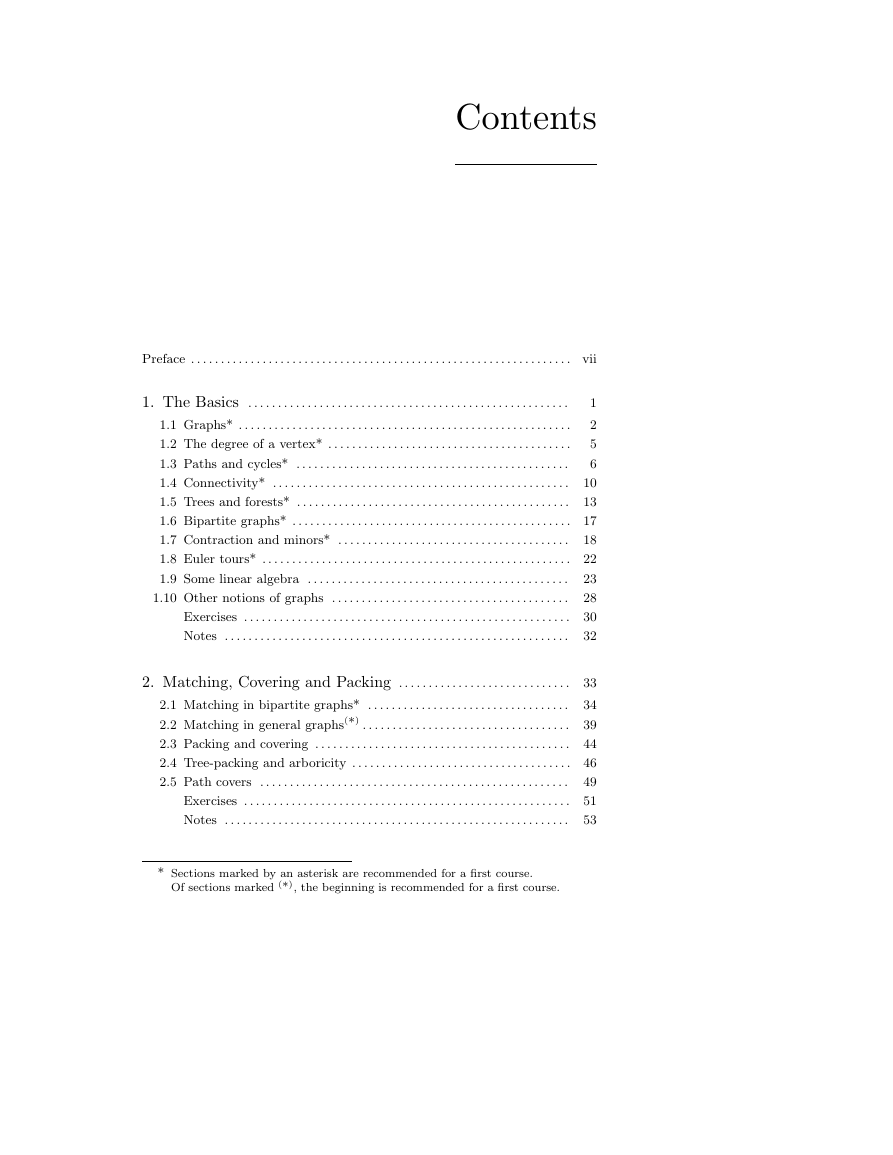








 2023年江西萍乡中考道德与法治真题及答案.doc
2023年江西萍乡中考道德与法治真题及答案.doc 2012年重庆南川中考生物真题及答案.doc
2012年重庆南川中考生物真题及答案.doc 2013年江西师范大学地理学综合及文艺理论基础考研真题.doc
2013年江西师范大学地理学综合及文艺理论基础考研真题.doc 2020年四川甘孜小升初语文真题及答案I卷.doc
2020年四川甘孜小升初语文真题及答案I卷.doc 2020年注册岩土工程师专业基础考试真题及答案.doc
2020年注册岩土工程师专业基础考试真题及答案.doc 2023-2024学年福建省厦门市九年级上学期数学月考试题及答案.doc
2023-2024学年福建省厦门市九年级上学期数学月考试题及答案.doc 2021-2022学年辽宁省沈阳市大东区九年级上学期语文期末试题及答案.doc
2021-2022学年辽宁省沈阳市大东区九年级上学期语文期末试题及答案.doc 2022-2023学年北京东城区初三第一学期物理期末试卷及答案.doc
2022-2023学年北京东城区初三第一学期物理期末试卷及答案.doc 2018上半年江西教师资格初中地理学科知识与教学能力真题及答案.doc
2018上半年江西教师资格初中地理学科知识与教学能力真题及答案.doc 2012年河北国家公务员申论考试真题及答案-省级.doc
2012年河北国家公务员申论考试真题及答案-省级.doc 2020-2021学年江苏省扬州市江都区邵樊片九年级上学期数学第一次质量检测试题及答案.doc
2020-2021学年江苏省扬州市江都区邵樊片九年级上学期数学第一次质量检测试题及答案.doc 2022下半年黑龙江教师资格证中学综合素质真题及答案.doc
2022下半年黑龙江教师资格证中学综合素质真题及答案.doc